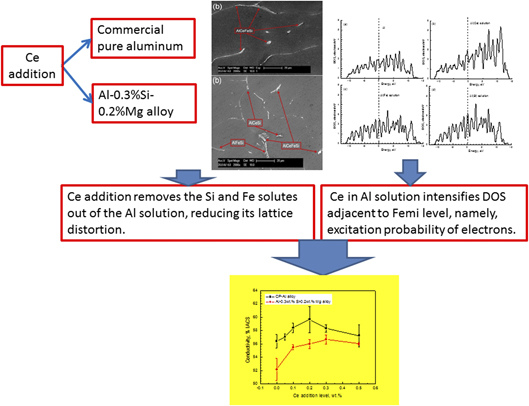Crossref Citations
This article has been cited by the following publications. This list is generated based on data provided by
Crossref.
Feng, Wei
Jian, Mao
Chunfang, Liu
and
Huihua, Liu
2018.
Effect of Trace Elements La, Ti and Homogenization on Electrical Properties of Pure Aluminum.
Rare Metal Materials and Engineering,
Vol. 47,
Issue. 11,
p.
3257.
Sidelnikov, S.
Voroshilov, D.
Motkov, M.
Voroshilova, M.
and
Bespalov, V.
2020.
Development of Combined Machining Modes, Investigation of Mechanical Properties and Structure of Deformed Semi-Finished Products from Alloy 01417.
Materials Science Forum,
Vol. 992,
Issue. ,
p.
498.
Jiang, Hongxiang
Li, Shixin
Zheng, Qiuju
Zhang, Lili
He, Jie
Song, Yan
Deng, Congkun
and
Zhao, Jiuzhou
2020.
Effect of minor lanthanum on the microstructures, tensile and electrical properties of Al-Fe alloys.
Materials & Design,
Vol. 195,
Issue. ,
p.
108991.
Bespalov, Vadim
Sidelnikov, Sergey
Berngardt, Viktor
Voroshilov, Denis
Yakivyuk, Olga
Bermeshev, Timofey
Durnopyanov, Alexander
Kulishova, Elena
and
Voroshilova, Marina
2020.
Investigation of the Structure and Properties of Deformed Semi-Finished Products from Alloys of the Al-REM System Made by the Method of Ingotless Rolling-Extruding.
Key Engineering Materials,
Vol. 837,
Issue. ,
p.
9.
Sidelnikov, Sergey
Sokolov, Ruslan
Voroshilov, Denis
Motkov, Mikhail
Bespalov, Vadim
Voroshilova, Marina
Sokolova, Svetlana
Rudnitskiy, Edvard
Lebedeva, Olga
and
Borisyuk, Vera
2020.
Modeling the Process of Obtaining Bars from Aluminum Alloy 01417 by Combined Rolling-Extruding Method with Application of the Deform-3D Complex.
Key Engineering Materials,
Vol. 861,
Issue. ,
p.
540.
Czerwinski, Frank
2020.
Cerium in aluminum alloys.
Journal of Materials Science,
Vol. 55,
Issue. 1,
p.
24.
Wang, Yu
Zhu, Langjie
Niu, Guodong
and
Mao, Jian
2021.
Conductive Al Alloys: The Contradiction between Strength and Electrical Conductivity.
Advanced Engineering Materials,
Vol. 23,
Issue. 5,
Sidelnikov, Sergey Borisovich
Voroshilov, Denis Sergeevich
Motkov, Mikhail Mikhaylovich
Timofeev, Viktor Nikolaevich
Konstantinov, Igor Lazarevich
Dovzhenko, Nikolay Nikolaevich
Lopatina, Ekaterina Sergeevna
Bespalov, Vadim Mikhaylovich
Sokolov, Ruslan Evgenyevich
Mansurov, Yulbarskhon Nabievich
and
Voroshilova, Marina Vladimirovna
2021.
Investigation structure and properties of wire from the alloy of AL-REM system obtained with the application of casting in the electromagnetic mold, combined rolling-extruding, and drawing.
The International Journal of Advanced Manufacturing Technology,
Vol. 114,
Issue. 9-10,
p.
2633.
Li, Wan-Peng
Zhang, Yu-Liang
and
Mao, Jian
2021.
Enhanced strength and electrical conductivity of Al–0.3Ce alloy simultaneously with Ti(C,N) nanoparticle addition.
Rare Metals,
Vol. 40,
Issue. 7,
p.
1890.
Voroshilov, D.
Sidelnikov, S.
Bespalov, V.
Kovaleva, A.
and
Nazarenko, D.
2021.
Development of Combined Rolling-Extruding Modes for Producing Longish Deformed Semi-Finished Products from Aluminum Alloy with Low Cerium Content.
Key Engineering Materials,
Vol. 887,
Issue. ,
p.
262.
Tie, Di
Guan, Renguo
Wang, Zhi
Fu, Ying
Zhang, Jin
Chen, Xiaolin
Wang, Yuxiang
Ling, Cheng
and
Cai, Minghui
2021.
High electrical conductivity Al-Ag-Sc-Zr alloy with ultrafine grains processed by accumulative continuous extrusion.
Materials Letters,
Vol. 286,
Issue. ,
p.
129227.
Sidelnikov, S.
Voroshilov, D.
Motkov, M.
Bespalov, V.
and
Voroshilova, M.
2021.
Experimental and Analytical Assessment of the Power Parameters of the Combined Rolling-Extruding Process Using a Round Billet from Alloy 01417 Obtained Using an Electromagnetic Mold.
Key Engineering Materials,
Vol. 887,
Issue. ,
p.
300.
Czerwinski, Frank
2022.
Critical Minerals for Zero-Emission Transportation.
Materials,
Vol. 15,
Issue. 16,
p.
5539.
Wang, Yu
Zhu, Langjie
and
Mao, Jian
2023.
High-Strength Conductive Al-0.5 Mg-1.0Si Alloys Modified by Ce and Cu.
Journal of Materials Engineering and Performance,
Vol. 32,
Issue. 3,
p.
1357.
Voroshilov, Denis Sergeevich
Sidelnikov, Sergey Borisovich
Konstantinov, Igor Lazarevich
Lopatina, Ekaterina Sergeevna
Zagirov, Nikolay Nikolaevich
Mansurov, Yulbarskhon Nabievich
Motkov, Mikhail Mikhaylovich
Galiev, Roman Ilsurovich
Ber, Vladimir Ivanovich
Bespalov, Vadim Mikhaylovich
and
Belokonova, Irina Nikolaevna
2023.
Simulation of combined rolling-extrusion process for round section billets in closed box caliber.
The International Journal of Advanced Manufacturing Technology,
Vol. 127,
Issue. 5-6,
p.
2893.
Lin, Guojian
Li, Lu
Guo, Zhengwei
Jia, Xianjun
Wang, Xiao
Yuan, Zhentao
Zhang, Guoxing
Zhan, Yun
Shan, Quan
and
Li, Zulai
2024.
Influence of cerium and yttrium addition on strength and electrical conductivity of pure aluminum alloys.
Journal of Rare Earths,
Vol. 42,
Issue. 3,
p.
600.
Voroshilov, Denis Sergeevich
Sidelnikov, Sergey Borisovich
Bespalov, Vadim Mikhaylovich
Sokolov, Ruslan Evgenyevich
Bermeshev, Timofey Vladimirovich
Berngardt, Viktor Aleksandrovich
Lezhnev, Sergey Nikolaevich
Durnopyanov, Alexander Vasilyevich
Kovaleva, Angelina Adolfovna
Konstantinov, Igor Lazarevich
Novikova, Olga Sergeevna
and
Motkov, Mikhail Mikhaylovich
2024.
Combined rolling-extrusion of various billets from the Al–Ce–La alloy for electrical wire production.
The International Journal of Advanced Manufacturing Technology,
Vol. 131,
Issue. 9-10,
p.
4699.
Bespalov, Vadim Mikhaylovich
Voroshilov, Denis Sergeevich
Berngardt, Viktor Aleksandrovich
Sidelnikov, Sergey Borisovich
Konstantinov, Igor Lazarevich
Durnopyanov, Alexander Vasilyevich
Baykovskiy, Yuriy Viktorovich
Motkov, Mikhail Mikhaylovich
Bermeshev, Timofey Vladimirovich
Bespalova, Diana Dmitrievna
Voroshilova, Marina Vladimirovna
and
Mansurov, Yulbarskhon Nabievich
2024.
Influence of the Parameters of Combined Processing and Drawing on the Structure and Properties of Conductor Semi-finished Products From Aluminum Alloys with Additives of Rare Earth and Transition Metals.
Metals and Materials International,
Vol. 30,
Issue. 3,
p.
773.
Niu, Guodong
Wang, Yu
and
Mao, Jian
2024.
Superior Strength and Electrical Conductivity Synergy of Cold‐Drawn Al–Mg–Si–Ce–Cu Wires Produced by Continuous Casting and Rolling.
Advanced Engineering Materials,






